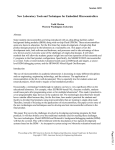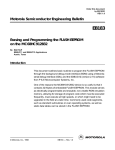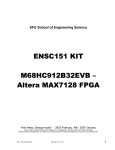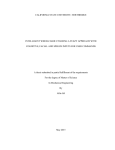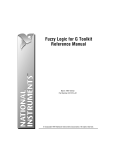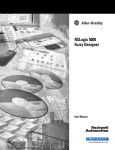Download Paper - Asee peer logo
Transcript
Session 2520 Fuzzy Logic on the MC68HC12 Microcontroller: A Student Design Workshop Christopher R. Carroll, Marian S. Stachowicz Electrical and Computer Engineering University of Minnesota Duluth Abstract Fuzzy Logic is a practical alternative for challenging control applications that provides a convenient method for constructing nonlinear controllers via the use of heuristic information from human designers. Such heuristic information is recorded in rules describing how to control the process. Fuzzy Logic emulates the human decision-making process, and provides a user-friendly formalism for representing and implementing highperformance control at low cost. Until recently, Fuzzy Logic has been used primarily on large-scale computing systems, at least at the level of personal computers. Recent advances, however, make it realistic to implement Fuzzy Logic techniques on small systems based on microcontrollers. Implemented most commonly in control design, Fuzzy Logic-based systems can be found in a rapidly growing number of consumer appliances, from dishwashers to video cameras, as well as in automobile engines and transmissions, and other industrial equipment. Still others are putting Fuzzy Logic to work in pattern recognition, economics, and other areas that involve a high level of uncertainty, complexity, or nonlinearity. Motorola’s MC68HC12 microcontroller includes features that promote Fuzzy Logic implementations by incorporating several Fuzzy Logic primitives directly in its instruction set. It includes specific assembly language instructions that implement the Fuzzy Logic operations of trapezoidal membership, rule evaluation, and weighted average defuzzification. Additional instructions that are helpful in Fuzzy Logic applications include min/max instructions and table lookup operations. This set of features makes the MC68HC12 microcontroller uniquely suited to low-level applications that make use of Fuzzy Logic principles. Page 5.312.1 This paper describes a student design workshop conducted in the Electrical and Computer Engineering (ECE) Department at the University of Minnesota Duluth (UMD) in which students implemented microcontroller applications using the principles of Fuzzy Logic as contained in the features of the MC68HC12 microcontroller. This workshop provided students with a unique opportunity to merge their academic understanding of Fuzzy Logic techniques with their ability to design and implement microcontroller systems. The paper describes the MC68HC12 microcontroller features that support Fuzzy Logic, introduces Fuzzy Logic and intelligent control, and details student projects suggested in this design workshop. The goals of these studies are: to illustrate Fuzzy Logic theory, to apply Fuzzy Logic features of the MC68HC12, and to implement applications of fuzzy control. Setting The workshop described in this paper was conducted as an offering of the course ECE 4951, “Design Workshop,” during the Spring semester, 2000. This workshop course is one mechanism by which students completing the ECE program at UMD can satisfy the requirement for a senior design project. In this workshop, each student individually completes his or her own project, but all students are working on the same basic topic, which, in this case, was Fuzzy Logic applications of the MC68HC12 microcontroller. Since each student has an individual project, he or she is responsible for the complete design. Since all students are working as part of a class environment and completing their projects using similar hardware and software tools, a team environment develops in which students can learn from each other and benefit from experiences of other students. This setting makes an ideal environment for a class to learn together while solving problems associated with individual projects. Lab Hardware This workshop class used the Motorola M68EVB912B32 Evaluation Board (EVB) as the focus for student projects. The EVB contains a MC68HC12 microcontroller mounted on a circuit board that includes a standard RS-232 serial port for communication with a host such as a personal computer (PC), miscellaneous power conditioning, clock generation, and reset components, and a wire-wrap area for adding custom circuits to the standard board. This standard board served as the foundation for student projects. Some students purchased their own boards and customized them for their individual projects. The workshop class environment provided five boards already equipped with the features described below. Page 5.312.2 The MC68HC12 includes many input/output (I/O) features internally in the microcontroller which expand on the features available in the popular MC68HC11 microcontroller used at many schools, including UMD, as the workhorse processor in introductory microprocessor classes. The MC68HC12 microcontoller is a 16-bit processor, whereas the MC68HC11 is an 8-bit processor. The larger word size improves performance. However, the hardware features of the MC68HC12 directly mimic the familiar features available on the MC68HC11. The MC68HC12 internally includes: 1. eight input/output ports (the MC68HC11 has five) 2. expanded timing functions (input capture and output compare) 3. improved serial ports (serial communications and serial peripheral interfaces) 4. improved eight-channel analog-to-digital converter 5. four pulse-width modulated outputs (none on the MC68HC11) 6. Byte Data Link Communication (BDLC) module (not on MC68CH11). These internal I/O features make the MC68HC12 an attractive vehicle to serve as the base for many different projects. In addition to the standard capabilities of the MC68HC12 microcontroller, the wire-wrap areas on the EVB’s which were supplied by the department for the workshop class were equipped to provide several additional input/output features for students to use in their projects. These additional wire-wrapped features consisted of 1. a small speaker using one output port bit to provide simple audio output 2. a Musical Instrument Digital Interface (MIDI) port for musical projects 3. an eight-digit seven-segment LED multiplexed display 4. a matrix alphanumeric keyboard 5. outputs to drive the video and horizontal/vertical sync signals for a CRT 6. an expansion socket to connect internal I/O features to the user’s circuit. With these additional I/O capabilities added to the basic MC68HC12 features, students had a wide range of hardware support for designing their projects. These features are described in more detail in an earlier paper1. The 68HC12 EVB systems provided the foundation for each of the student projects in this workshop class. By making use of the various I/O features available internally in the microcontroller and wire-wrapped on the expansion area of the EVB, students had a broad collection of capabilities for interfacing their projects. Lab Software Students verified preliminary project ideas using the Fuzzy Logic Package5 for Mathematica from Wolfram Research, Inc. The Fuzzy Logic Package supplies users with an essential set of functions for creating, modifying, and visualizing fuzzy sets and fuzzy logic-based systems. The package also uses digital fuzzy sets, which makes fuzzy sets easier to understand and apply to practical, real world problems. Students can use the package’s built-in functions at every stage of the fuzzy logic design process. Writing software for the MC68HC12 microcontroller is an easy job for students who have experience with the MC68HC11. Students in this workshop class had already completed the introductory microprocessor class at UMD in which they learned how to program the MC68HC11 and use its internal I/O features. The instruction set of the MC68HC12 microcontroller is s superset of the MC68HC11’s instruction set, so, for the most part, students could pretend they were back in the introductory class programming the MC68HC11. Details of using the internal I/O features of the MC68HC12 differ slightly from those on the MC68HC11, and the added features wire-wrapped on the Page 5.312.3 expansion part of the EVB were new to students, but generally, making software work on the MC68HC12 EVB was not a challenge to students. Provided with the EVB from Motorola is a collection of system software that aids in program development on PC hosts. This includes an assembler, and a programming environment that facilitates downloading assembled programs into the memory of the EVB system. The EVB stations provided to workshop students used this software on PC hosts to implement the lab stations for the workshop course. The MC68HC12 microcontroller includes internal program memory that is used by student applications for writing software. This memory includes 1K bytes of Random Access Memory (RAM), (half of which is used by Motorola’s on-board monitor software!), 768 bytes of Electrically Erasable and Programmable Read Only Memory (EEPROM) as found in the MC68HC11, and 32K bytes of Flash EEPROM containing Motorola’s monitor program, which can be erased and replaced with the user’s application code. Although the amount of RAM is minimal, the availability of the two kinds of EEPROM eases crowding of user code in memory. The Flash EEPROM has a very limited lifetime of only about one hundred erase/program cycles, and so is not useful for program development. Memory expansion is possible, at the expense of some of the microcontroller’s I/O capability. Fuzzy Logic on the MC68HC12 The MC68HC12 microcontroller includes several instructions in its instruction set that are specifically meant to support Fuzzy Logic applications. These instructions are: 1. MEM – evaluates trapezoidal membership functions 2. REV/REVW – perform unweighted/weighted MIN-MAX rule evaluation 3. WAV – performs weighted average defuzzification These instructions are described in this section. In addition to these specialized functions, the MC68HC12 instruction set has also been expanded to include more generic operations such as min/max calculations and table lookup actions that help to facilitate Fuzzy Logic operations. Page 5.312.4 The MEM instruction evaluates trapezoidal membership functions. These functions are at the heart of the definition of fuzzy sets, the foundation for Fuzzy Logic. Membership functions define the degree to which a particular value or element belongs to a set, on a scale from 00 to FF in hexadecimal. The degree of membership ramps up linearly from 00 to FF over a specified range of input values. It then remains at FF for a specified interval, and then ramps back down to 00 over another specified range. The trapezoidal shape of this membership function characterizes the degree to which a particular value belongs to the set being defined. In using the MEM instruction, the programmer first defines the function in a data structure in memory. Then the MEM instruction is applied to a particular input value to determine the extent to which it belongs in the set, from 00 (not at all) to FF (completely). This process is known as fuzzification, and results in a set of fuzzy values that describe characteristics of input variables in the system. Rule evaluation using the REV and REVW instructions in the MC68HC12’s instruction set is the process by which Fuzzy Logic performs calculations. These calculations are evaluated by processing the fuzzy values produced by MEM through a number of rules that describe the system. In unweighted rule evaluation, using REV, all rules have equal importance in determining the result. In weighted rule evaluation, using REVW, some rules may have more impact on the result than others through a weighting system that multiplies the result of a given rule evaluation by a fractional weight between 0 and 1. In the process of evaluating a specific rule, fuzzy values are combined via a MIN operation to represent the logistical “and” operator, while results of several rule evaluations are combined via a MAX operation to represent the logistical “or” operator. The result of the rule evaluation process is a set of fuzzy outputs that describe the degree to which each output should have specific values in the system. The results at this point are not usable as final outputs of the calculation because the fuzzy values indicate only the degree to which an output should have a specific value, not the final value itself. The final step in Fuzzy Logic calculations is the defuzzification step, performed by the WAV instruction. WAV uses the fuzzy output values produced by REV or REVW and the list of specific possible output values to calculate a weighted average value for each output variable in the system. WAV accomplishes this task by calculating a sum of products of each possible output value times the fuzzy value corresponding to that output and by calculating the sum of all the fuzzy values. The first of these sums is divided by the second using a separate divide instruction to produce the overall value of the final output variable. Typical Student Projects Students taking this design workshop were given several suggestions for possible projects, and encouraged to develop ideas on their own as well. Generally, the best projects involved control of some physical variable based on measurements of various environmental conditions. One project suggestion involved control of a heater in a water boiling application. The controller’s job was to ensure that the temperature of the heated water did not deviate from a programmed heating cycle beyond a specified error level. Medical applications included an automatic anesthesia controller that regulated administration of drugs to anesthetized patients. A rapid charger for batteries was described for students, as well as environmental controllers for a wide range of settings. Other applications involved potentially more complex controllers. These included voice recognition systems controlled by Fuzzy Logic, and traffic control devices for both highways and for feeder streets. Students were encouraged to pursue applications in areas of their own interests, including hobbies such as music, photography, model control, and other situations. Page 5.312.5 Conclusion This workshop experience provided an excellent opportunity for students to merge information they had gained in two different disciplines, Fuzzy Logic and Microprocessor Systems, into one project design. By requiring students to use the common foundation of the MC68HC12 EVB hardware, and encouraging them to take advantage of the various features of the processor that support Fuzzy Logic, students gained an excellent understanding of the two disciplines and how they relate to each other. This merging of disciplines in a final capstone project is the intent of the senior design experience in engineering programs. This workshop class was successful in combining knowledge students had gained in several different classes. Bibliography 1. Carroll, C. R., “Design Workshop Experience Using the Motorola 68HC12 Microcontroller,” Proceedings of the 1998 North Midwest Section Meeting of ASEE, Winona, MN (1998). 2. Motorola Semiconductor, “Technical Summary:16-Bit Microcontroller: MC68HC912B32,” Technical report M68HC912B32TS/D, Motorola, Inc. (1997). 3. Motorola Semiconductor, “M68EVB912B32 Evaluation Board User’s Manual,” Technical report 68EVB912B32UM/D, Motorola, Inc. (1997). 4. Motorola Semiconductor, “CPU12 Reference Manual,” Motorola, Inc. (1997). 5. Stachowicz, M.S., Lance Beall, “Fuzzy Logic Package for Mathematica,” Wolfram Research, Inc (1998). 6. J. Yen, Rr. Langari, Fuzzy Logic, Prentice Hall (1999). Biography CHRISTOPHER R. CARROLL received a Bachelor of Engineering Science degree from Georgia Tech and M.S. and Ph.D. degrees from Caltech. After serving in the Electrical Engineering department at Duke University, he is now Associate Professor and Assistant Head of Electrical and Computer Engineering at the University of Minnesota Duluth. His interests include special-purpose digital systems, VLSI, and microprocessor applications, especially as they relate to educational environments. MARIAN S. STACHOWICZ is professor and Jack Rowe chair at the University of Minnesota Duluth. He received his M.S. degree in Control and Computer Engineering from LETI in Leningrad and both his Ph.D. and D.S. degrees from AGH in Cracow. His work centers on system theory, fuzzy set theory, and their applications. He is a Senior Member of IEEE. Page 5.312.6






